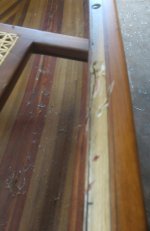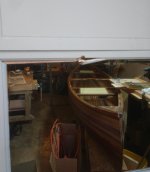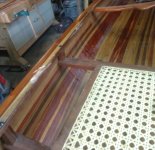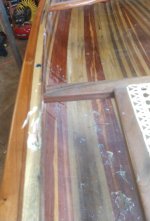I have been trying to avoid wading into this debate .. but here I go. I will be assuming that gluing means using epoxy, I don't think gunnel application, on a stripper, is an appropriate use for regular wood glue.
Asking a single, unqualified question like this suggests that there is a "best" solution to gunnel application .... personally, I think the type of gunnels and the application may change with circumstance. A rental boat that gets beaten up and needs the gunnels replaced every few years would likely benefit from an easier replacement option, some one building for weight and strength may opt for an epoxied gunnel. So depending on your own circumstance, the best option may vary ... JFF made the point that he the would screw on at least the outer gunnels, so a composite copy could be made, in that case is there really any other choice? Maybe you are going for a "period" appropriate look, again, these are all reasons for selecting a certain methodology.
I am a builder, i do take my boats to the wilds, portage and hit the occasion rock ( I swear there are a few assassin rocks every trip, hiding, waiting for me to pass) so things like reliability, weight and convenience all come into how I build my craft. I am also not one to "throw my toys around", I want that boat ready to take me where I need to go ... they aren't coddled, but I see no need to drive a boat onto shore or into rocks, afterall, it is my ticket home.
When I am building, one rule I have is that all exposed wood gets sealed ... when I drill the holes for the thwarts/seat(s) etc. those holes get sealed, usually during the varnishing process, I put a finger over one side and fill the hole with varnish to seal ... then release and continue. I would suggest that this necessary step is not included in a lot of gunnel applications using screws, it is likely assumed that the screw will seal the wood (or it seems like a lot of effort), which it won't. Anyone who has backed a screw out of exposed wood after a few years knows that the entire screw is usually suffering water damage.
Going down that long gunnel and drilling dozens of holes, is definitely going to impact the strength of that strip ... and then using dozens of screws to fasten it in place is going to add a not insignificant weight. Now with a full size (3/4" x 3/4" seems to be the accepted norm) gunnel set, the holes won't reduce strength to an unacceptable level ... however, since the full strength of the gunnel set isn't achieved due to the holes, it also means that a glued set can be smaller and still give comparable strength ... with a weight saving from less wood and no screws. This may or may not be of value to the builder, as I said .... it is all about circumstance and what the builder is trying to achieve.
Glen
"Wouldn't they be more likely to spring apart if the glue fails after a time than screwed gunwales would?"
As I stated at the start, I don't think a regular wood glue is appropriate for this application, I would only use epoxy as the surfaces will likely be slightly irregular and in the case of a stripper you are making a bond between epoxy and wood, so a void filling epoxy is the best product IMO. As far as longevity goes, my first gunnels have only seen 8 years with no issues ... but I haven't had a single properly done epoxy joint fail in that time, so I do not believe that the glued on gunnel is prone to any sort of spontaneous springing apart.
"Wouldn't glued gunwales be harder to remove from the hull, if necessary, than screwed gunwales?"
There is no question that a glued set will more difficult to remove, more so if they are done properly ... of course done properly and there should be less reason to remove them as well. While I agree they would be more difficult, I suspect you aren't looking at a huge task either, several power tools could simplify the task and time it takes, again IMO.
At the end of the day:
- the screwed gunnels are 1) heavier 2) more work to prep and apply 3) easier to remove
- the glued gunnels are 1) lighter 2) less work to prep and apply 3) more work to remove
Your build, use and how you use your craft will dictate which is best for your personal use ... I don't believe there is a overall best here, there will however be an overall best for each application.
Brian
Asking a single, unqualified question like this suggests that there is a "best" solution to gunnel application .... personally, I think the type of gunnels and the application may change with circumstance. A rental boat that gets beaten up and needs the gunnels replaced every few years would likely benefit from an easier replacement option, some one building for weight and strength may opt for an epoxied gunnel. So depending on your own circumstance, the best option may vary ... JFF made the point that he the would screw on at least the outer gunnels, so a composite copy could be made, in that case is there really any other choice? Maybe you are going for a "period" appropriate look, again, these are all reasons for selecting a certain methodology.
I am a builder, i do take my boats to the wilds, portage and hit the occasion rock ( I swear there are a few assassin rocks every trip, hiding, waiting for me to pass) so things like reliability, weight and convenience all come into how I build my craft. I am also not one to "throw my toys around", I want that boat ready to take me where I need to go ... they aren't coddled, but I see no need to drive a boat onto shore or into rocks, afterall, it is my ticket home.
When I am building, one rule I have is that all exposed wood gets sealed ... when I drill the holes for the thwarts/seat(s) etc. those holes get sealed, usually during the varnishing process, I put a finger over one side and fill the hole with varnish to seal ... then release and continue. I would suggest that this necessary step is not included in a lot of gunnel applications using screws, it is likely assumed that the screw will seal the wood (or it seems like a lot of effort), which it won't. Anyone who has backed a screw out of exposed wood after a few years knows that the entire screw is usually suffering water damage.
Going down that long gunnel and drilling dozens of holes, is definitely going to impact the strength of that strip ... and then using dozens of screws to fasten it in place is going to add a not insignificant weight. Now with a full size (3/4" x 3/4" seems to be the accepted norm) gunnel set, the holes won't reduce strength to an unacceptable level ... however, since the full strength of the gunnel set isn't achieved due to the holes, it also means that a glued set can be smaller and still give comparable strength ... with a weight saving from less wood and no screws. This may or may not be of value to the builder, as I said .... it is all about circumstance and what the builder is trying to achieve.
Glen
"Wouldn't they be more likely to spring apart if the glue fails after a time than screwed gunwales would?"
As I stated at the start, I don't think a regular wood glue is appropriate for this application, I would only use epoxy as the surfaces will likely be slightly irregular and in the case of a stripper you are making a bond between epoxy and wood, so a void filling epoxy is the best product IMO. As far as longevity goes, my first gunnels have only seen 8 years with no issues ... but I haven't had a single properly done epoxy joint fail in that time, so I do not believe that the glued on gunnel is prone to any sort of spontaneous springing apart.
"Wouldn't glued gunwales be harder to remove from the hull, if necessary, than screwed gunwales?"
There is no question that a glued set will more difficult to remove, more so if they are done properly ... of course done properly and there should be less reason to remove them as well. While I agree they would be more difficult, I suspect you aren't looking at a huge task either, several power tools could simplify the task and time it takes, again IMO.
At the end of the day:
- the screwed gunnels are 1) heavier 2) more work to prep and apply 3) easier to remove
- the glued gunnels are 1) lighter 2) less work to prep and apply 3) more work to remove
Your build, use and how you use your craft will dictate which is best for your personal use ... I don't believe there is a overall best here, there will however be an overall best for each application.
Brian





